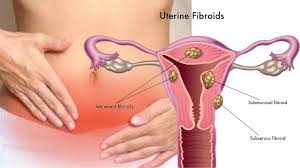Uterine fibroids are very common non-cancerous (benign) growths that develop in the muscular wall of the uterus, also referred to as leiomyoma, leiomyomata, myoma and fibromyoma. They can range from very tiny to a very large size. While fibroids do not always cause symptoms, their size and location can lead to problems for some.
Fibroids can dramatically increase in size during pregnancy due to increase in estrogen levels. After pregnancy, the fibroids usually shrink back to their pre-pregnancy size. They typically improve after menopause when the level of estrogen decreases dramatically.
About 20% to 80% of women develop fibroids by the age of 50.
Most fibroids don’t cause symptoms—only 10 to 20 percent of women require treatment. Depending on size, location and number of fibroids, they may cause:
- Heavy, prolonged menstrual periods
- Pelvic pain and pressure
- Pain in the back and legs
- Pain during sexual intercourse
- Bladder pressure leading to a frequent urge to urinate
- Pressure on the bowel, leading to constipation and bloating
- Abnormally enlarged abdomen
Depending on the site in uterus they are referred to by different names:
Intramural Fibroids – are the most common appearing within muscle lining of uterus
Subserosal Fibroids– develop under outside covering of the uterus giving the uterus a knobby appearance
Pedunculated Fibroids- When subserosal tumors develop a stem they become pedunculated.
Submucosal Fibroids– These develop in the inner lining (endometrium) of your uterus & are not as common. They may cause heavy menstrual bleeding, trouble getting pregnant and miscarriages.
Cervical fibroids are located in the wall of the cervix (neck of the uterus)
 Diagnosis is made on history, examination and an ultrasound at the gynecologist’s office as part of the evaluation process. In some patient MRI may be advised.
Diagnosis is made on history, examination and an ultrasound at the gynecologist’s office as part of the evaluation process. In some patient MRI may be advised.
Symptomatic uterine fibroids can be treated by:
- medication to control symptoms or shrinking tumors
- ultrasound fibroid destruction or radio frequency ablation
- Myomectomy
- Hysterectomy
- uterine artery embolization
Myomectomy is a surgery to remove fibroids, recommended for women who want fertility preserving surgery or want to retain uterus. There are four types of myomectomy: Hysteroscopic, Laparoscopic, Robotic and Laparotomic or open.
Minimal Invasive Myomectomy– Robotic or Laparoscopic has less pain; less blood loss and shorter hospital stay than open surgery. Not that one size fits all; hence surgery is best discussed with the specialist. Since fibroids can recur in the reproductive years, option of uterine artery ligation should be discussed with the doctor to prevent recurrence.

